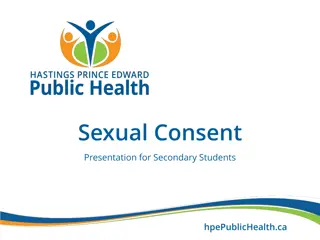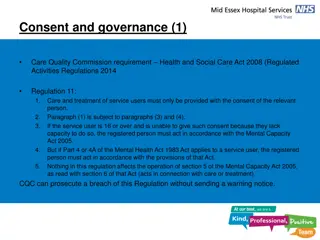Effective Communication and Consent in Healthcare
This content emphasizes the importance of communication, consent, and candor in healthcare, promoting the principles of realistic medicine. It discusses the need for evidence-based practices, understanding patient preferences, encouraging open discussions about treatment options and goals, and respecting patient choices. The content also addresses barriers to effective communication, the duty of care in obtaining consent, and the significance of providing information on material risks to patients. Overall, the focus is on fostering compassionate and informed patient-centered care.
Download Presentation

Please find below an Image/Link to download the presentation.
The content on the website is provided AS IS for your information and personal use only. It may not be sold, licensed, or shared on other websites without obtaining consent from the author.If you encounter any issues during the download, it is possible that the publisher has removed the file from their server.
You are allowed to download the files provided on this website for personal or commercial use, subject to the condition that they are used lawfully. All files are the property of their respective owners.
The content on the website is provided AS IS for your information and personal use only. It may not be sold, licensed, or shared on other websites without obtaining consent from the author.
E N D
Presentation Transcript
Communication Consent And Candour Nothing about me without me @whitworthce #realisticmedicine Caroline Whitworth
Evidence-basePatient context Patient preferences
Encourage discussion What do you understand about what has been happening? What matters to you? If there is a change in your condition, can we talk about the things you might want to happen, and what you would not want to happen... Can we talk about the choices we have and any decisions that you would want to make?
Do not offer options based upon unrealistic expectations or goals. When appropriate explain why non effective treatment options e.g CPR , ICU will not help Talk about what you can do to help. Offer supportive or palliative care as an option. Utilise the TEP on TRAK to document plans for inpatients Compassionately negotiate demands for treatment should they arise. Death remains an unavoidable outcome irrespective of treatment in many circumstances. SR Workman BMJ 2019
Barriers to effective communication Expectations Patient, family, clinician Conversations reluctance, time (workload), place, capacity Focus on Specialty versus multi-system, holistic on Outcomes Bias? Trust - Duration and depth of relationship with patient Information sharing ACPs, KIS, TEP
Consent and Montgomery a duty of care to warn of material risks. The test of materiality defined in the Montgomery ruling was whether a reasonable person in the patient s position would be likely to attach significance to the risk, or the doctor is or should reasonably be aware that the particular patient would be likely to attach significance to it. Reflects good practice as recommended by GMC
Consent It is a process not a form It requires effective two-way communication Why do patients sue? Analysis of claims tends to revolve around the precipitating clinical factors, such as a delay in diagnosis, incorrect surgical technique or medication error. However, the risk of complaint and litigation appears to have much more to do with predisposing factors such as our communication skills, sensitivity to patient needs and management of expectations, than the complexity of the patient s condition, patient characteristics or technical and clinical skills. By focusing on patient centred care, effective communication and empowerment, the relationship between doctors and patients is strengthened and the risk of litigation is therefore reduced. Dinwoodie, Medical Protection Society
Documentation Clinic letters - for patient specific information Write letter to the patient and cc to the GP, other health care professionals summarise your discussion about treatment options, risks, benefits, patient preferences and outcome of Shared decision-making Back up with Patient information Leaflets for generic information about procedures.
Professional Duty of Candour Every healthcare professional must be open and honest with patients when something that goes wrong with their treatment or care causes, or has the potential to cause, harm or distress. This means that healthcare professionals must: tell the patient (or, where appropriate, the patient s advocate, carer or family) when something has gone wrong apologise to the patient (or, where appropriate, the patient s advocate, carer or family) offer an appropriate remedy or support to put matters right (if possible) explain fully to the patient (or, where appropriate, the patient s advocate, carer or family) the short and long term effects of what has happened. GMC
Organisational Duty of Candour Health (Tobacco, Nicotine etc. and Care) (Scotland) Act 2016 (The Act) and The Duty of Candour Procedure (Scotland) Regulations 2018 Organisations (as responsible persons) must activate the duty of candour procedure as soon as reasonably practicable after becoming aware that: an unintended or unexpected incident occurred in the provision of the health, care or social work service provided by the organisation as the responsible person; in the reasonable opinion of a registered health professional (as defined in Annex C) not involved in the incident: (a) that incident appears to have resulted in or could result in any of the outcomes mentioned below; and (b) that outcome relates directly to the incident rather than to the natural course of the person's illness or underlying condition.
How do we manage this? Using Datix to report all adverse incidents Major Harm or Death Moderate harm which may meet Organisational duty of candour Review by PSEAG on each Site Commissioning of a SAE review Must be at least led by individual(s) external to the team involved in patient care if potentially meeting Organisational DoC A Focus on learning.......not blame Outcomes 3 A different plan and/or delivery of care may have resulted in a different outcome though uncertainty regarding impact on patient outcome/ event. 4 A different plan and or delivery of care, on balance of probability, would have been expected to result in a more favourable outcome, i.e. how case was managed had a direct impact on the level of harm
Relevant Outcomes are any of: The death of the person. Permanent lessening of bodily, sensory, motor, physiologic or intellectual functions (including removal of the wrong limb or organ or brain damage) ("severe harm"). Harm which is not severe harm but which results in one or more of the following criterion: an increase in the person's treatment; changes to the structure of the person's body; the shortening of the life expectancy of the person; an impairment of the sensory, motor or intellectual functions of the person which has lasted, or is likely to last, for a continuous period of at least 28 days; the person experiencing pain or psychological harm which has been, or is likely to be, experienced by the person for a continuous period of at least 28 days. The person requires treatment by a registered health professional in order to prevent: the death of the person; any injury to the person which, if left untreated, would lead to one or more of the outcomes mentioned in paragraph B or C.
Other material Learn Pro Module on Realistic Medicine (in Optional courses) http://intranet.lothian.scot.nhs.uk/Directory/c apacityandconsent/Pages/default.aspx https://www.gmc-uk.org/ethical- guidance/ethical-guidance-for- doctors/decision-making-and-consent/the- seven-principles-of-decision-making-and- consent























